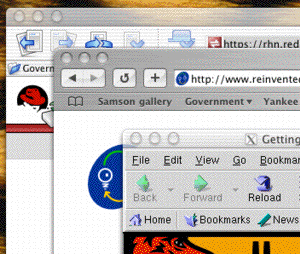 As noted by many, Apple also release an X11 server for OS X on Tuesday. While this isn’t a revolutionary release — the same capabilities have been available using XDarwin for some time — the new server is much zippier, and better integrated into the desktop environment.
As noted by many, Apple also release an X11 server for OS X on Tuesday. While this isn’t a revolutionary release — the same capabilities have been available using XDarwin for some time — the new server is much zippier, and better integrated into the desktop environment.
What the hell am I talking about?
Well, best explanation is through an example: there is a Linux server sitting, behind a firewall, 1/2 a mile from me. Using a VPN, I can connect to the server, and using the X11 server in my local Mac, I can run software on that machine that is displayed locally. For example, right now I’m running the Mozilla browser from that server, but its windows are being displayed on my own computer’s screen. When I save files, they get saved on that computer’s hard disk.
The network really is the computer.
Pictured right are Chimera and Safari, running locally, and Mozilla, running under X11 from the aforementioned server 1/2 mile away. Neato.
 I am
I am
Comments
When you say VPN how is that
When you say VPN how is that - like using PC anywhere?
I have a solution waiting for a problem - SDSL modems that can link two locations using a 2 wire data circuit that cost $18.65/mo. The link is 2.1Mb and is the same speed both ways unlike DSL (my DSL upload rate is 12Kbytes/s).
You can transfer files at 200Kbytes/s plus, both ways!
The SDSL modems also route IP with tables, fully configurable.
If you need to link two offices this is the cheapest fastest way I know of.
Who will sell you a 2-wire
Who will sell you a 2-wire circuit for $18.65/mo? Here on the Island, the last time I checked, the cost was upwards of $75/mo.
Aliant sells me one now, I
Aliant sells me one now, I use it to connect my home to my office in Tyne Valley, but it did cost $190 to install.
My 2 wire circuit is about 5km including a 4km detour up to the Aliant CO. In Charlottetown the CO is on 56 Fitzroy St, it must be included in the circuit so really it is best for downtown - downtown links.
Those circuits are called
Those circuits are called LDDS (Limited Distance Data Service) they, oddly, come with no “services” of any kind and are just that, a pair of wires. There’s also the two-pair variety and both of these are sold (or were last time I checked) at $16 ($18.83 taxes in) per mile (or part there of) per pair of wires. They are (were?) available for locations within 5 miles of the CO and Island Tel used hundreds of them, whacked on 1Mb modems, and called it DSL for a year or so until they got real DSL up and running satisfactorily (did they yet?).
Brilliant - I didn’t think
Brilliant - I didn’t think anyone knew of these.
They are also alarm circuits for companies like Chubb, open/close loop for alarm.
Flowpoint modem/routers can do 2.1Mb up to 3km.
In Tyne Valley as many rural places in PEI there is a long waiting list for high-speed - years long. So I use my circuit to extend the high-speed from my office to my house, plus I map a hard drive from my office PC to my home PC since the Flowpoint carries NetBIOS as well.
The one virtue is no bottleneck upstream as with my Aliant high-speed. I can only upload to the net at 12kbytes/s, but I can send files both ways across my SDSL two wire circuit at 200kbytes/s.
What is the upload limit using Eastlink cable modems?
My Aliant DSL works well, my
My Aliant DSL works well, my IP has never changed.
In fact, access my personal library at 142.176.28.95
User: temp1 Pswd: temp1 Domain:leave blank
If you want your own username email me.
Enjoy!
Add new comment